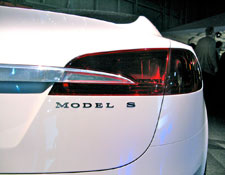
by Ralph Allora
Recently Motor Trend magazine named the Tesla Model S its 2013 Car of the Year. It was the first time in the award’s history that the honor has gone to an all-electric vehicle. Down the road, this moment may be remembered as a turning point in public acceptance of electric vehicles. For now, it serves as a broader branding lesson for makers of sustainable, eco-friendly products.
How to win over a tough crowd
Your author has spent some time in the automotive media trenches—Motor Trend was his former employer—and he can report that this is a world not particularly receptive to new ideas about sustainability. The car-guy crowd (it’s still mostly guys) has premium unleaded coursing through its veins. If they’re honoring an alternative-fueled vehicle, you can be reasonably assured that it’s not based on the car’s longterm benefits to society.
No, they’re impressed by other things—things like performance, quality, luxury and design. Not coincidentally, those are exactly the factors for which the Tesla Model S is praised in the opening of the Motor Trend Car of the Year article.
What’s conspicuously absent in the opener is any reference to the Model S being an electric vehicle. It’s a deliberate omission, one that Motor Trend readily acknowledges:
“Wait. No mention of the astonishing inflection point the Model S represents—that this is the first COTY winner in the 64-year history of the award not powered by an internal combustion engine? [Yet] it’s only a part of the story. At its core, the Tesla Model S is simply a damned good car you happen to plug in to refuel.”
And there you have it. Marketers of sustainable, eco-friendly goods and services would do well to share that “damned good car” quote with everyone in their company, because it sums up how a niche market player moves towards larger success. It’s the difference between Tesla staying, well, Tesla, or eventually competing for market share with the likes of Audi or Infiniti.
It’s about quality and design first
Aside from a relatively small group of hardcore, eco-driven purists, consumers are not yet ready to embrace a product based solely on the idea that it burns natural resources at a slower rate than other, similar products. They will embrace it, however, if it’s better, safer, faster, stronger, or more beautiful in its design. The saving-the-planet part is icing on the cake, as it were.
(“Cheaper,” it must be noted, is not mentioned here as a consumer benefit, because it’s not a realistic proposition. Not yet, anyway. Until eco-friendly products achieve a favorable economy of scale in manufacturing and distribution, they will mainly be accessible only to consumers on the high end of the socioeconomic spectrum. Those who can afford the $58,000 Tesla Model S, for example, are undoubtedly shopping on quality, not price.)
An all-electric vehicle will not sell if it’s little more than a glorified golf cart. It will sell, however, if it inspires a gut-level, emotional reaction—the kind we experienced when we first laid eyes on the Model S in person this past summer (and made it the subject of our first-ever blog post).
If you’re marketing a sustainable, low-carbon-footprint product, and you’re hoping to expand your brand’s awareness and acceptance beyond the safe lap pool of true believers into the choppier waters of those with different priorities, never lose sight of this fact. Your earth-saving solution will be widely celebrated if—and only if—it also happens to be a damned good product.
Ralph Allora is co-founder and marketing director of TRAY Creative, a Seattle-based creative agency specializing in brand identity, marketing campaigns and web solutions for forward-looking companies and nonprofits.
Flickr image: By jurvetson
